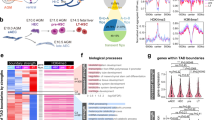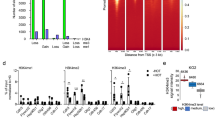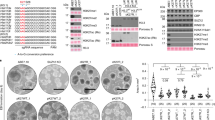Abstract
In embryonic stem cells (ESCs), Wnt-responsive development-related genes are silenced to maintain pluripotency and their expression is activated during differentiation. Acetylation of histones by histone acetyltransferases stimulates transcription, whereas deacetylation of histones by HDACs is correlated with transcriptional repression. Although Wnt-mediated gene transcription has been intimately linked to the acetylation or deacetylation of histones, how Wnt signaling regulates this type of histone modification is poorly understood. Here, we report that Smek, a regulatory subunit of protein phosphatase 4 (PP4) complex, plays an important role in histone deacetylation and silencing of the Wnt-responsive gene, brachyury, in ESCs. Smek mediates recruitment of PP4c and HDAC1 to the Tcf/Lef binding site of the brachyury promoter and inhibits brachyury expression in ESCs. Activation of Wnt signaling during differentiation causes disruption of the Smek/PP4c/HDAC1 complex, resulting in an increase in histones H3 and H4 acetylation at the brachyury gene locus. These results suggest that the Smek-containing PP4 complex represses transcription of Wnt-responsive development-related genes through histone deacetylation, and that this complex is essential for ESC pluripotency maintenance.
Similar content being viewed by others
Log in or create a free account to read this content
Gain free access to this article, as well as selected content from this journal and more on nature.com
or
References
Clevers H . Wnt/beta-catenin signaling in development and disease. Cell 2006; 127:469–480.
Grunstein M . Histone acetylation in chromatin structure and transcription. Nature 1997; 389:349–352.
Forsberg EC, Downs KM, Christensen HM, et al. Developmentally dynamic histone acetylation pattern of a tissue-specific chromatin domain. Proc Natl Acad Sci USA 2000; 97:14494–14499.
Wöhrle S, Wallmen B, Hecht A . Differential control of Wnt target genes involves epigenetic mechanisms and selective promoter occupancy by T-cell factors. Mol Cell Biol 2007; 27:8164–8177.
Billin AN, Thirlwell H, Ayer DE . Beta-catenin-histone deacetylase interactions regulate the transition of LEF1 from a transcriptional repressor to an activator. Mol Cell Biol 2000; 20:6882–6890.
Daniels DL, Weis WI . Beta-catenin directly displaces Groucho/TLE repressors from Tcf/Lef in Wnt-mediated transcription activation. Nat Struct Mol Biol. 2005; 12:364–371.
Lindsley RC, Gill JG, Kyba M, Murphy TL, Murphy KM . Canonical Wnt signaling is required for development of embryonic stem cell-derived mesoderm. Development 2006; 133:3787–3796.
Gingras AC, Caballero M, Zarske M, et al. A novel, evolutionarily conserved protein phosphatase complex involved in cisplatin sensitivity. Mol Cell Proteomics 2005; 4:1725–1740.
Chowdhury D, Xu X, Zhong X, et al. A PP4-phosphatase complex dephosphorylates gamma-H2AX generated during DNA replication. Mol Cell 2008; 31:33–46.
Mendoza MC, Du F, Iranfar N, et al. Loss of SMEK, a novel, conserved protein, suppresses MEK1 null cell polarity, chemotaxis, and gene expression defects. Mo. Cell Biol 2005; 25:7839–7853.
Wolff S, Ma H, Burch D, et al. SMK-1, an essential regulator of DAF-16-mediated longevity. Cell 2006; 124:1039–1053.
Sousa-Nunes R, Chia W, Somers WG . Protein phosphatase 4 mediates localization of the Miranda complex during Drosophila neuroblast asymmetric divisions. Genes & Dev. 2009; 23:359–372.
Keller G . Embryonic stem cell differentiation: emergence of a new era in biology and medicine. Genes & Dev 2005; 19:1129–1155.
Yuasa S, Itabashi Y, Koshimizu U, et al. Transient inhibition of BMP signaling by Noggin induces cardiomyocyte differentiation of mouse embryonic stem cells. Nat Biotechnol 2005; 23:607–611.
Moretti A, Caron L, Nakano A, et al. Multipotent embryonic isl1+ progenitor cells lead to cardiac, smooth muscle, and endothelial cell diversification. Cell 2006; 127:1151–1165.
Aubert J, Dunstan H, Chambers I, Smith A . Functional gene screening in embryonic stem cells implicates Wnt antagonism in neural differentiation. Nat Biotechnol 2002; 20:1240–1245.
Qyang Y, Martin-Puig S, Chiravuri M, et al. The renewal and differentiation of Isl1+ cardiovascular progenitors are controlled by a Wnt/beta-catenin pathway. Cell Stem Cell 2007; 16:165–179.
Laugwitz KL, Moretti A, Caron L, Nakano A, Chien KR . Islet1 cardiovascular progenitors: a single source for heart lineages? Development 2008; 135:193–205.
Wilkinson DG, Bhatt S, Herrmann BG . Expression pattern of the mouse T gene and its role in mesoderm formation. Nature 1990; 343:657–659.
Yamaguchi TP, Takada S, Yoshikawa Y, Wu N, McMahon AP . T (Brachyury) is a direct target of Wnt3a during paraxial mesoderm specification. Genes & Dev 1999; 13:3185–3190.
Canettieri G, Morantte I, Guzmán E, et al. Attenuation of a phosphorylation-dependent activator by an HDAC-PP1 complex. Nat Struct Biol 2003; 10:175–181.
Lagger G, O'Carroll D, Rembold M, et al. Essential function of histone deacetylase 1 in proliferation control and CDK inhibitor repression. EMBO J 2002; 21:2672–2681.
Cole MF, Johnstone SE, Newman JJ, Kagey MH, Young RA . Tcf3 is an integral component of the core regulatory circuitry of embryonic stem cells. Genes & Dev 2008; 22:746–755.
Sato N, Meijer L, Skaltsounis L, Greengard P, Brivanlou AH . Maintenance of pluripotency in human and mouse embryonic stem cells through activation of Wnt signaling by a pharmacological GSK-3-specific inhibitor. Nat Med 2004; 10:55–63.
Singh AM, Li FQ, Hamazaki T, et al. Chibby, an antagonist of the Wnt/beta-catenin pathway, facilitates cardiomyocyte differentiation of murine embryonic stem cells. Circulation 2007; 115:617–626.
Kioussi C, Briata P, Baek SH, et al. Identification of a Wnt/Dvl/beta-Catenin → Pitx2 pathway mediating cell-type-specific proliferation during development. Cell 2002; 111:673–685.
Anton R, Kestler HA, Kühl M . Beta-catenin signaling contributes to stemness and regulates early differentiation in murine embryonic stem cells. FEBS Lett 2007; 581:5247–5254.
Takao Y, Yokota T, Koide H . Beta-catenin up-regulates Nanog expression through interaction with Oct-3/4 in embryonic stem cells. Biochem Biophys Res Commun 2007; 353:699–705.
Naito AT, Shiojima I, Akazawa H, et al. Developmental stage-specific biphasic roles of Wnt/beta-catenin signaling in cardiomyogenesis and hematopoiesis. Proc Natl Acad Sci USA 2006; 103:19812–19817.
Roose J, Molenaar M, Peterson J, et al. The Xenopus Wnt effector XTcf-3 interacts with Groucho-related transcriptional repressors. Nature 1998; 395:608–612.
Tay Y, Zhang J, Thomson AM, Lim B, Rigoutsos I . MicroRNAs to Nanog, Oct4 and Sox2 coding regions modulate embryonic stem cell differentiation. Nature 2008; 455:1124–1128.
Boyer LA, Lee TI, Cole MF, et al. Core transcriptional regulatory circuitry in human embryonic stem cells. Cell 2005; 122:947–956.
Bakre MM, Hoi A, Mong JC, et al. Generation of multipotential mesendodermal progenitors from mouse embryonic stem cells via sustained Wnt pathway activation. J Biol Chem 2007; 282:31703–31712.
Kuo MH, Allis CD . Roles of histone acetyltransferases and deacetylases in gene regulation. Bioessays 1998; 20:615–626.
Nichols J, Evans EP, Smith AG . Establishment of germ-line-competent embryonic stem (ES) cells using differentiation inhibiting activity. Development 1990; 110:1341–1348.
Ying QL, Nichols J, Chambers I, Smith A . BMP induction of Id proteins suppresses differentiation and sustains embryonic stem cell self-renewal in collaboration with STAT3. Cell 2003; 115:281–292.
Acknowledgements
The authors would like to thank people from the Lu lab for constructive discussions. Jungmook Lyu was supported by a postdoctoral fellowship from CIRM. This work was partially supported by the CIRM Basic Biology Award (RB1-01353-1) and a grant from NIH (1R01NS067213-01A1).
Author information
Authors and Affiliations
Corresponding authors
Additional information
( Supplementary information is linked to the online version of the paper on the Cell Research website.)
Supplementary information
Supplementary information, Figure S1
Overexpression of Smek reduces differentiation of ESCs into mesoderm. (PDF 53 kb)
Supplementary information, Figure S2
Depletion of Smek inhibits neuroectoderm differentiation from ESCs. (PDF 117 kb)
Supplementary information, Figure S3
Localization of β-catenin in ESCs knocked down for Smek1 and Smek1. (PDF 172 kb)
Supplementary information, Figure S4
Occupancy of Smek at Tcf/Lef binding site region of islet1 and pitx2. (PDF 57 kb)
Supplementary information, Figure S5
Smek increases binding of HDAC1 to Tcf protein. (PDF 81 kb)
Supplementary information, Figure S6
The knockdown for PP4c induces differentiation of ESCs. (PDF 112 kb)
Supplementary information, Figure S7
Smek-mediated blockade of transcriptional activation by Wnt/β-catenin signaling is dependent on the dose of Wnt3a protein. (PDF 72 kb)
Supplementary information, Figure S8
β-catenin-independent Wnt signaling increases brachyury expression. (PDF 59 kb)
Supplementary information, Data S1
Materials and Methods (PDF 70 kb)
Rights and permissions
About this article
Cite this article
Lyu, J., Jho, Eh. & Lu, W. Smek promotes histone deacetylation to suppress transcription of Wnt target gene brachyury in pluripotent embryonic stem cells. Cell Res 21, 911–921 (2011). https://doi.org/10.1038/cr.2011.47
Received:
Revised:
Accepted:
Published:
Issue date:
DOI: https://doi.org/10.1038/cr.2011.47
Keywords
This article is cited by
-
Identification of protein phosphatase 4 catalytic subunit as a Wnt promoting factor in pan-cancer and Xenopus early embryogenesis
Scientific Reports (2023)
-
Mutation in Smek2 regulating hepatic glucose metabolism causes hypersarcosinemia and hyperhomocysteinemia in rats
Scientific Reports (2023)
-
SMEK1 promotes lung adenocarcinoma proliferation and invasion by activating Wnt/β-catenin signaling pathway
Clinical and Translational Oncology (2022)
-
β-catenin-independent regulation of Wnt target genes by RoR2 and ATF2/ATF4 in colon cancer cells
Scientific Reports (2018)
-
Application of a Bayesian non-linear model hybrid scheme to sequence data for genomic prediction and QTL mapping
BMC Genomics (2017)



